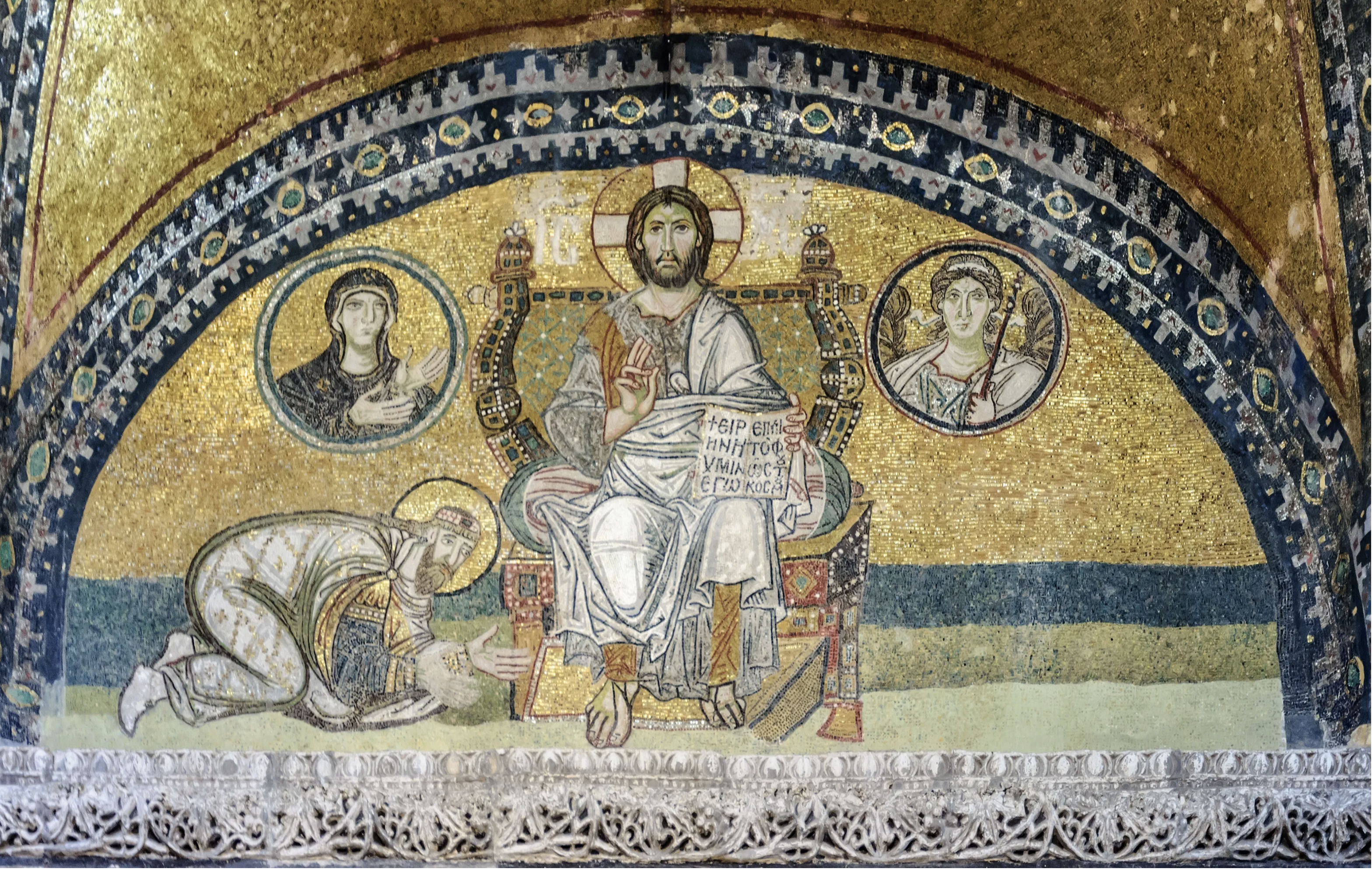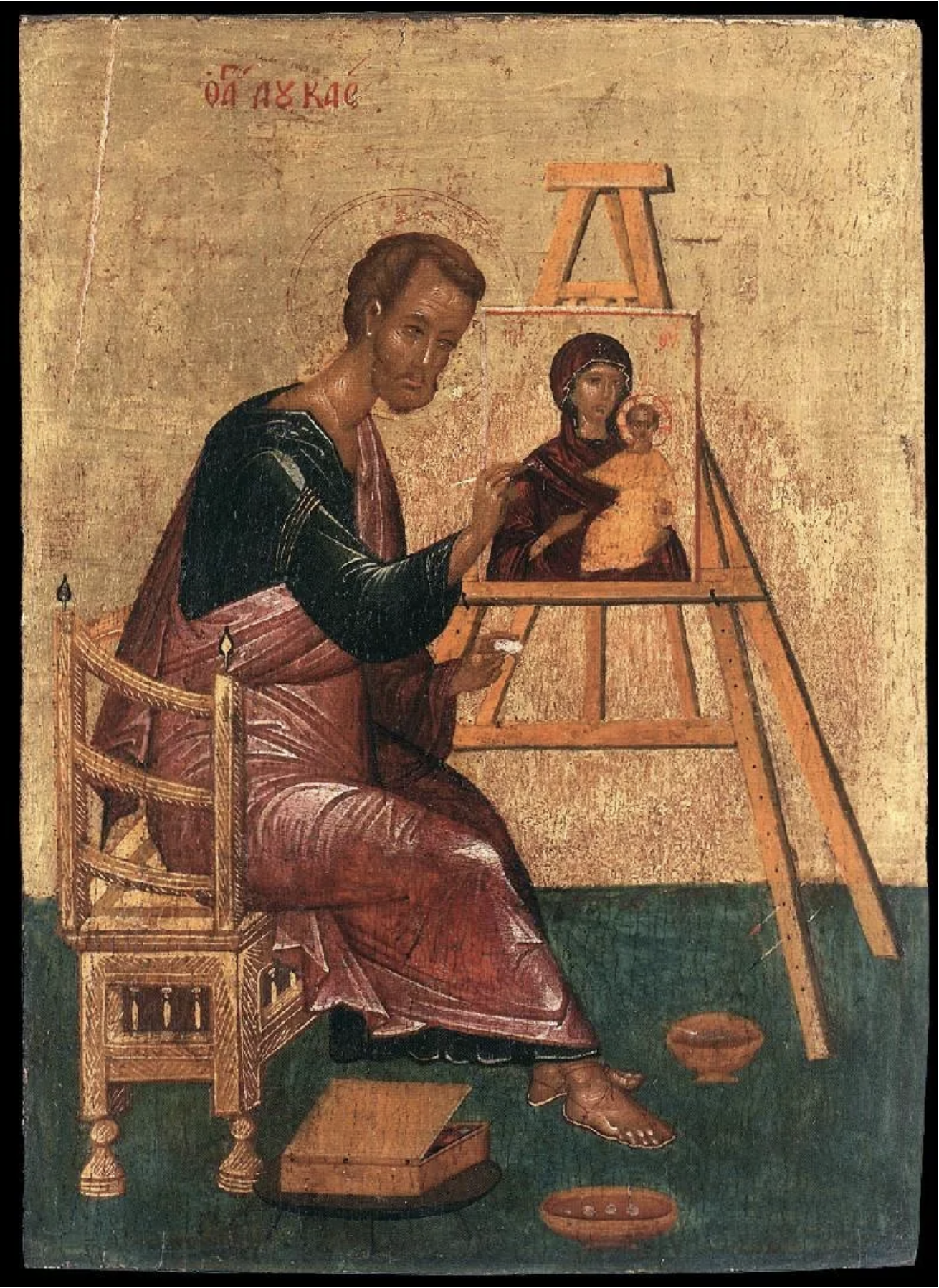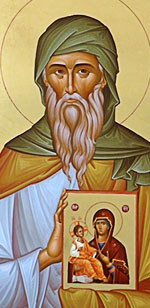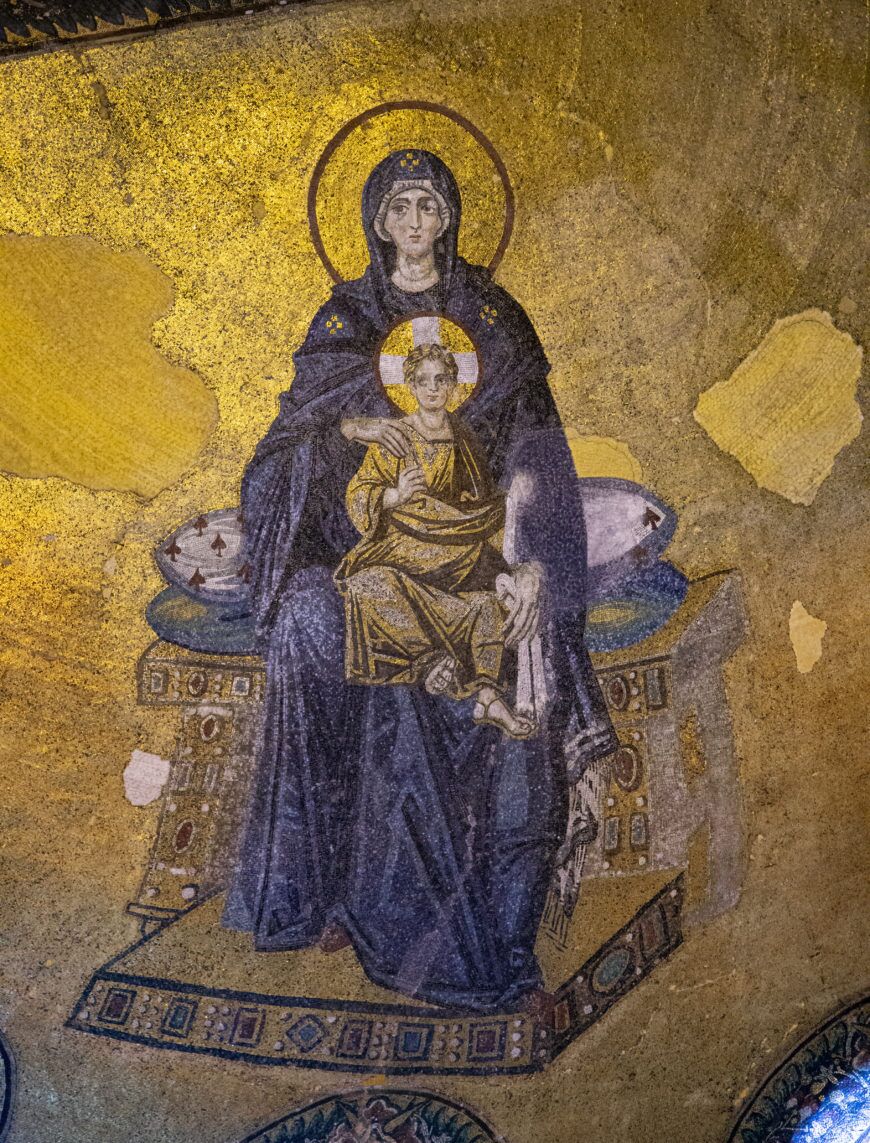
John 20:1-10 (Matins)
Hebrews 13:7-16
John 17:1-13
The Un-secret
"Hark ye yet again — the little lower layer. All visible objects,
man, are but as pasteboard masks. But in each event — in the living act,
the undoubted deed — there, some unknown but still reasoning thing puts
forth the mouldings of its features from behind the unreasoning mask. If man
will strike, strike through the mask!"
(Moby Dick, Chapter 36, (Captain Ahab speaking.)
Thus spoke the man driven on in his quest,
chasing a white whale, fueled
by an electric mania,
on all sides striving to strike through the mask of life.

The feverish urge to destroy icons is a haunting riddle.
From what deep place does it proceed?
Where does it come from?
The Church was not rocked by controversy over the perceived failure
to keep other commandments
however universally broken.
For example,
how many Christians (in any age) religiously refrain from all work on Sundays?
We've come to a point where people think
that this is only practiced in monasteries.
Moreover,
the case alleging icons as idolatry is a weak one.
St. Luke was a painter of icons.
And the Early Church acknowledged that gold images of the Seraphim adorned the Mercy Seat,
which delighted YHWH Who sat upon it.
And for centuries the Church had attested the Sacred Tradition of icons.
From where, then, does this unease
(perhaps I should call it disease)
come from?
The proximate context of iconoclasm
is the rise of Islam,
which forbade all icons.
For example,
when the Emperor Justinian II ordered
the Image of Christ to be stamped on the front
of Byzantine coinage
in 695,
the Caliph Abd al-Malik, ruler of the Caliphate to the Empire's East and Southeast,
objected.
Speaking in our language today,
we would call this "an international incident."
For Islamic territories (though disunited) stretched
to the east as far as Kandahar,
to the north as far as the Caucasus,
and
to the south as far as Yemen and the Indian Ocean.
By 634,
the whole Levant,
including Syria,
had become Muslim.
Meantime, the Western Roman Empire since the early fifth century
had disintegrated
due to the rising power of antagonists on their borders,
chiefly the Germanic tribes to the north.
In 476 the Germanic king Odoacer deposed the last Western Roman Emperor.
The succeeding centuries would become a free-for-all among rivals
in the Roman West.
Assaults on the Eastern Roman Empire in the eighth century
seemed to be following
the same plot line.
During the winter of 717-718 an armada of 1,800 Muslim vessels
descended upon Constantinople,
threatening to spread the Islamic ummah
westward to Europe.
The military hero who won the day was Leo III the Isaurian (r. 717-741),
the new Emperor of the Eastern Empire.
Now, Leo was by nature a practical man,
a general through and through.
And as he looked out upon his newly acquired empire,
he saw it in terms of inefficiencies
that threatened to weaken
military strength.
Chief among his complaints was the Church, which (from his point of view) had been lavished
with untold riches, enjoyed egregious privileges,
and, most important,
sapped the empire of manpower.
The population of monks by the turn of the eighth century had surpassed 100,000,
and
their
fealty was not to their emperor.
Nor was their service to the polis.
Theirs was a pledge of absolute faithfulness to an otherworldly kingdom.
And their energies were directed
perpetually upon icons,
gazing through windows opening on to a fantasy land
from Leo's perspective.
Moreover,
this counter-culture,
composed of fabulously wealthy estates,
was exempt from taxation
—
a double-blow to his war machine.
The time had come, the emperor decided, to pull the plug on all these television screens
(as we would say)
and
awaken these people from this "unwholesome trance."

When the Patriarch of Constantinople, ironically named Germanus,
resisted the removal of icons,
he was deposed and then exiled.
So the fight had to be led from without.
St. John of Damascus (c. 652-749)
had written extensively in defense of icons.
And he was beyond the reach of Leo III
being a monk of the great Monastery of Saint Sabas
in Palestine
—
a land controlled by Muslims.
John Damascene's argument was a tour de force.
The first icon painter, he argued in effect,
was God the Father,
Who painted the first Icon before all ages.
But we must not say that the Father created the Son,
for that would be to make Him a mere creature.
It is better to say that this creative power is an inextricable part of the Divine Nature:
In former times God, Who is without form or body, could never be depicted. But now
when God is seen in the flesh conversing with men, I make an image of the God Whom I see.
I do not worship matter; I worship the Creator of matter who became matter for my sake,
who willed to take His abode in matter, who worked out my salvation through matter.
Never will I cease honoring [fr. proskynesis] the matter which wrought my salvation!
(On the Holy Images, 1.16).
|
John is careful to contradistinguish "worship"
(latreia)
from
"veneration"
(proskynesis).
Seeing the allies of God being lined up against him,
both inside and outside of the empire,
and
calculating the profound backlash that was gathering like
an enormous ground swell,
Leo III relented
and
permitted the controversy to die down.
He was succeeded by his son the Emperor Constantine V (r. 741-775),
who saw himself as a theologian
and
arrogated to the title of "priest."
He began a program of clearing the episcopate of iconodules
and
replacing them with iconoclasts
building up an ecclesiastical army
in readiness
to strip the empire of icons.
But other problems distracted him.
In the year of his imperial accession, he faced a coup attempt
by his brother-in-law,
so he set about
securing his son's claim to the throne by making him
a co-emperor virtually from birth.
At age twenty-five, this young man, Leo IV, succeeded his father
and reigned for five years.
Leo IV's son acceded to the throne as a boy and crowned emperor at age nine under the regency of
his mother the Empress Irene.
But the boy behaved erratically,
making catastrophic decisions,
and was overthrown by his mother who gave orders to blind him and put him in prison.
He died of his wounds.
Irene would reign for only five years,
but in that time she managed to convoke an
ecumenical council,
the Second Council of Nicaea
(seventh in the sequence of universal councils).
As we know,
this Council would issue decrees protecting icons down to our own time.
☦
Worldliness in its way is comforting.
After all,
it's what we know without effort.
Now, I don't mean "comforting"
in the sense of sensual pleasures (though there is that).
I mean that nothing is required of us.
We just drift along in a numb sameness each day
pursuing the unchallenging and unrevealing familiar.
Over time, though, we realize that
we do not know who we are or what we are,
and
the familiar is no longer as comforting as it was.
The deeper meaning of our life and our identity is lost to us.
We say, "life has passed us by,"
for we have never taken hold
—
not bothering to reflect on our lives,
forgoing an examination of conscience each day,
not addressing God in prayer,
and,
most important,
not hearing the word of the Living God, which enters us
piercing even to the division of soul and spirit, and of joints and marrow,
and is a discerner of the thoughts and intents of the heart.
(Heb 4:12)
|
Our God speaks into each of our lives.
We must respond.
We must not ignore our God Who calls to us.
Otherwise,
we commence living not life, but a living death.
God lays us open and examines every aspect of our lives
in the blinding light of His perfect gaze.
All things are known.
Nothing remains hid.
And finally,
we have traction.
Here life begins.
When I was called to the priesthood,
friends said to me,
"Why would you do that?
That world is nothing but guilt trips?
Catholics don't know how to get past their hangups.
They're hung up on guilt!"
What they were saying is this:
a man of faith lives in intimacy with his re-awakened conscience.
But worldly people have gone through the process of silencing their consciences.
Yes, at first it is a painful process ....
but after a while the alarms of conscience stop ringing so loudly
until
at length they do not ring at all.
This re-wakening,
this coming to know things as they are is "icon life,"
is life among the saints in light.
No longer are we content to live life in a semi-darkness ....
until we die and pass on as a shade among shadows.
No,
we reject two-dimensional life in "Flatland"
choosing instead to live with God and His holy ones "with deeps calling to deeps."
Suddenly, the familiar no longer reassures.
The homey becomes vaguely threatening.
The hospitable becomes inhospitable.
F. W. J. Schelling
(who began his university studies specializing in the Greek Fathers)
said this:
|
That which should have remained hidden but has come to light.
|
and
he appended a word to it
Unheimlich,
which he defined as "the un-secret."
The common definition for the German word Unheimlich, "unhomely," says more:
the familiar has become unfamiliar.
The comforting has become unsettling.
And what we saw as an uneventful world has become a threshold to revelation.
The "postcard world" falls away
opening on to a maze of God's making.
Nothing is wasted in God's art.
Nothing is disposable.
All things are revealing.
There is no random or meaningless,
and above all there are no coincidences.
It is the work of Christian life to peel off the shallows
to reveal the deeps.
After all, our Lord Jesus Christ has commanded us to move on from the quotidian world:
And everyone who has left houses or brothers or sisters or father or mother
or wife or children or lands, for My Name's sake, shall receive a hundredfold,
and inherit eternal life.
(Mt 19:29)
|
Elsewhere Jesus says that
those who have set their sights on family
and an expected inheritance
are "not fit for the Kingdom of God" (Lu 9:62).
Literally,
they do not fit into Divine life.
And He warns off such plans with unsettling words:
|
Jesus said to him, "Let the dead bury their own dead, but you go and preach the Kingdom of God."
(Lu 9:60)
|
The initial steps one takes in entering the monastery,
where re-awakened life proceeds,
is to burn down your whole world
and
to follow the saints in light.
It is a life of inner reflection,
of prayer,
and
a world of mystery and revelation.
Shall we depart from what we know
—
hearth and home
—
to enter into realms which at times seem surreal?
Shall we embark on the last great adventure
which is to follow God
—
unfamiliar at first but then deeply reassuring.
But if we choose the quotidian familiar,
mistaking it to be the real,
we shall find that it changes hideously in our very hands,
becoming a grotesque.
William Faulkner's short story, "A Rose for Emily,"
depicts a young woman who cannot bear to let go of the familiar
in the person of
her father who has died.
She keeps his corpse at home in secret,
desperate to cling to sameness
and
dedicated each day to keep up appearances.
But the truth will out.
Perhaps better known to our post-literate society
is the case of Norman Bates
(a creation of Alfred Hitchcock),
who cannot bear to be parted from his
dead
mother but chooses rather to be ruled by her decayed corpse.
He craves the unchanging orderly
turning his back on normal development,
whose primal forces break through anyway
in hideous form.
Or let us consider the family at the center of the iconoclast controversy,
the Isaurian Dynasty.
Their history reads like a Greek tragedy .... you know,
in one play
featuring
a king who has eaten his own sons secretly baked into a pie
or
in another play featuring
a king who finds himself in a carnal bed with his own mother.
Familiar and reassuring domesticity have given
way to the surreal and bizarre.
In the Isaurian world,
and in ours,
a chaos lurks behind the surfaces.
The grotesque is to be expected.
After all, isn't this irretrievably the final state of all material things?
The essence of the material world
is withering finitude,
the grotesque.
But the essence of the Divine is life,
beautiful eternal life.
The Apostles are clear on this point:
"two ways there are, life or death (Didache, 1).
Jesus' prayer to His Father (Jn 17:2) is the basis for our ancient
prayer, "To know You is eternal life."

Icons are not art.
They are not the comforting familiar.
They are instances of Schelling's Unheimlich.
They are the un-secret.
They are the eyes of eternity looking out on the unredeemed world
and
on the world's desperate attempts
to paper over the unspeakable
and
to domesticate the unutterable.
And in our grave sins against God,
vainly eradicating the holy (as if we ever could)
—
whether they cry out to Heaven from eighth-century Byzantium
or
from Soviet atheism
burning churches,
smashing icons,
and
murdering 100,000 clergy
or,
in our own time,
defiling and desecrating the Eucharist in giddy public ceremonies ....
we seek in the throes of our desperation
to smash through the mask of life,
like wounded animals,
like living souls lashed to a dying dog.
But
be sure of this:
the sober eyes of eternity watch.
They continue their holy witness,
and
they mercifully set before us a mirror disclosing the real
even as we deny our true natures,
the true nature of life,
and
the ultimate reality of everything.
But the eighth century has vanished like a dream,
and
all empires turn to dust.
Without fail, the eyes of the Holy Ones look on forever through their windows from Light.
In the poet's words,
An aged man is but a paltry thing,
A tattered coat upon a stick, ....
O sages standing in God's holy fire
As in the gold mosaic of a wall,
Come from the holy fire, perne in a gyre,
And be the singing-masters of my soul.
Consume my heart away; sick with desire
And fastened to a dying animal.
It knows not what it is; and gather me
Into the artifice of eternity.
(William Butler Yeats, "Sailing to Byzantium")
|
In the Name of the Father and of the Son and of the Holy Ghost.


